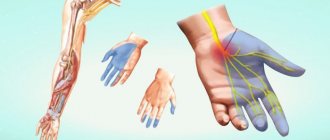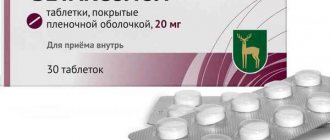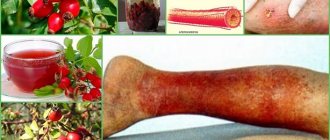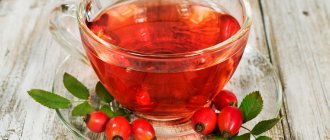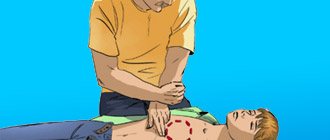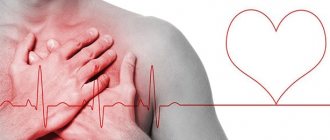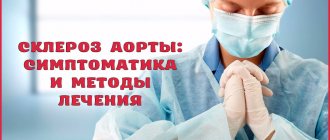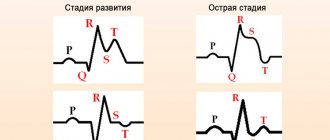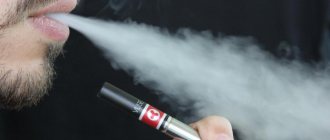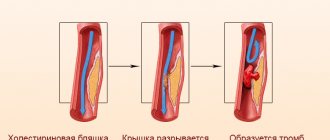- home
- Health
- ethnoscience
Restorative treatment of a heart attack with folk remedies is possible only under the supervision of a doctor. It is strictly forbidden to use traditional medicines during an acute attack of angina or emerging symptoms of myocardial infarction. But many folk remedies, proven over centuries, are included in the Russian pharmacopoeia and are used even in official medicine as auxiliary means for treating the consequences of an attack of coronary insufficiency.
Forms and clinical picture
It is prohibited to independently select medications and methods for improving the condition. Only a doctor, based on the results of the examination, will be able to tell how to treat myocardial infarction at home. The use of traditional recipes and tablets without consultation with a specialist will disrupt the treatment regimen, which will increase the likelihood of complications and recurrent heart attacks. In about every third person, a heart attack develops gradually. The reason for the increasing clinical picture is the appearance of the first attacks of angina and arrhythmia, destabilization of cardiac ischemia and the appearance of signs of heart failure. Such a pre-infarction condition can still be reversed if detected in a timely manner. Other forms of the disease are characterized by a sharp manifestation:
| Variety | Description |
| Anginal | It manifests itself as acute, burning and squeezing pain radiating to the neck, shoulder blades and upper extremities. The patient has a panic attack, breathing quickens, and the skin turns pale. It is not possible to relieve pain by taking Nitroglycerin. Simple medications with analgesic effects are also ineffective |
| Asthmatic | It develops mostly in older people against the background of advanced ischemia and hypertension. Symptoms of a heart attack are combined with a clinical picture characteristic of pulmonary edema (“noisy” breathing, obvious shortness of breath, developing into suffocation). Along with pale skin, blue discoloration of the nasolabial triangle becomes noticeable. Painful sensations appear similar to the anginal form or less pronounced |
| Infarction with cardiogenic shock | The clinical picture is dominated by pain. Against this background, cold sweat appears and blood pressure drops. Experts may confuse this form of heart attack with severe poisoning or internal bleeding |
| Arrhythmic | An irregular heartbeat becomes the first and most pronounced manifestation of an attack. Concerns are confirmed by electrocardiography |
| Cerebral | The most pronounced symptoms of brain hypoxia (dizziness, vomiting, blurred vision, sensory disturbances, headache). Cardiac signs are difficult to detect. Diagnosis problems arise due to the frequent combination of stroke (bleeding in the brain) and myocardial infarction |
| Abdominal | Among the first symptoms, pain in the stomach area stands out. The patient suffers from bouts of vomiting and bloating. Pain also occurs upon palpation. Abdominal infarction can be confused with an ulcer and inflammation of the pancreas |
“Silent” heart attacks are considered the most insidious. They actually do not appear and are often detected during electrocardiography.
The most likely symptoms are:
- general weakness;
- arterial hypotension in combination with mild tachycardia;
- fast fatiguability.
Symptoms
It is necessary to know the first symptoms of a heart attack, since it is important to provide medical assistance in this situation as early as possible. You should urgently call an ambulance if you have symptoms such as:
- Compressive, increasing pain behind the chest, which can radiate to the left half of the body, to the arm, neck, back, between the shoulder blades
- Pale skin
- Cold sweat, weakness
- Fainting
- Feeling of fear
- Duration of pain more than 15 minutes
- Ineffectiveness of nitroglycerin
It is worth considering that a heart attack is not always accompanied by such vivid symptoms; the pain may be completely absent or muted. You may experience shortness of breath or pain in the abdomen.
Common Treatment Methods
After hospitalization, the patient is under round-the-clock supervision by doctors in the intensive care unit. They will have to monitor the condition of the cardiovascular system and internal organs. As treatment, medications are used to resolve blood clots and improve vascular patency. Such therapy is especially relevant in the first hours after the onset of an attack.
The essence of further treatment is the use of drugs to reduce the amount of circulating blood. The heart will contract less frequently, which will reduce the myocardium’s need for oxygen and alleviate the patient’s condition. They combine the main treatment regimen with drugs designed to reduce blood clotting. They help prevent blood clots.
Surgery is recommended if it is not possible to alleviate the condition and improve heart function with the help of medications. It is carried out for:
- increasing the lumen of the coronary vessels;
- aneurysm excision;
- installation of an artificial pacemaker.
Timely initiation of treatment helps prevent irreversible changes in the myocardium. The first hours after the onset of an attack are especially important. In the future, the patient will have to remain in bed for a long time and undergo a course of intensive therapy. If we are talking about an extensive heart attack, then death is possible, regardless of the actions taken.
Features of the development of myocardial infarction
In fact, myocardial infarction always occurs due to blockage of the coronary arteries by atherosclerotic plaques. The nutrition of the heart is disrupted. Gradually, the plaques become covered with cracks into which platelets are directed. They become larger and can lead to the formation of a blood clot in the lumen of the vessel.
The following factors can directly or indirectly influence the development of a heart attack:
- Spasm of the coronary vessels contributes to the development of disruptions in hemodynamics (blood flow). It can manifest itself regardless of the severity of atherosclerosis, under the influence of other factors.
- The properties of blood play an important role in the pathogenesis of infarction. Its development is influenced by accelerated blood clotting and the amount of adrenaline released.
- In diabetes mellitus, glucose is not absorbed sufficiently. Its level in the blood increases, which leads to damage to blood vessels and an increased likelihood of blood clots.
The likelihood of a heart attack increases in people who do not follow healthy lifestyle rules:
- abuse of bad habits;
- constant physical and psycho-emotional stress;
- incorrectly composed diet;
- non-compliance with sleep patterns.
The impact of these factors leads to the appearance of excess body weight and disruptions in metabolic processes, accelerating the development of atherosclerosis. Some experts also highlight hereditary predisposition. According to statistics, heart attacks occur much more often in people who have close relatives suffering from various pathologies of the cardiovascular system.
Myocardial infarction occurs before the age of 50, 2-3 times more often in men. From 50 years of age and older, the rates level out for both sexes. A similar phenomenon is associated with the characteristics of the hormonal system in female representatives.
Diagnostics
At the first stages, the doctor examines the patient and listens to his complaints. This is sometimes enough to suspect myocardial infarction. In case of an acute attack, the first step is to administer a medicine to remove blood clots; at the second stage, a more serious diagnosis is carried out.
There are “hidden” forms of this disease, which can only be recognized using an electrocardiogram. The activity of serum enzymes is also taken into account, and an increase in myoglobin and creatine phosphokinase is determined. Diagnosis at a later stage includes an analysis for the enzyme lactate dehydrogenase, a biochemical blood test and coronary angiography.
Course of myocardial infarction
It is customary to divide myocardial infarction into several main periods. The treatment regimen and duration of each of them depends on the degree of damage, the condition of the blood vessels, the presence of other complications, the effectiveness of therapeutic methods and the patient’s compliance with the doctor’s recommendations. The following table will help you get acquainted with each stage:
| Period name | Peculiarities |
| Acute stage of development | The period lasts approximately 2 weeks. It is characterized by the replacement of dead tissue with granulation tissue and the highest chance of developing complications that can lead to death. Towards the end of the acute stage of development, the composition of the blood improves and the work of the heart muscle stabilizes, which can be seen on the cardiogram. The patient is transferred from intensive care to the cardiology department |
| Subacute period | The stage lasts about 1 month from the moment the first symptoms of a heart attack appear. The process of replacing the affected areas with connective tissue continues. The patient feels obvious relief. His blood composition, blood pressure and pulse improve. Doctors are gradually introducing light therapeutic exercises into the treatment regimen. Upon completion of the subacute stage, the patient is discharged. He will have to continue treatment at home and periodically visit a cardiologist with updated examination results. Spa treatment will help speed up the recovery process |
| Scarring stage | This stage can last from 2 months to six months. It is characterized by complete healing of the affected areas and their replacement with scar tissue. It shows up well on the ECG. |
Patient Actions
At the first signs or suspicions of a heart attack, it is necessary to urgently call an ambulance, because how quickly doctors remove the blood clot determines how much muscle tissue will be damaged. Before medical help arrives, you can take nitroglycerin tablets at a dosage of 0.5 mg every 15 minutes. Please note that you should not take more than 3 tablets, as severe hypotension may develop. Chewing aspirin at a dosage of 150-250 mg may also help. Monitor your blood pressure whenever possible.
Traditional methods of treatment
Discharge from the hospital does not mean complete recovery. The patient will be prescribed medications, physical therapy and other methods to speed up recovery. You can supplement the treatment regimen with traditional medicine. They cannot completely cure a person, but they can increase the effectiveness of the main course of therapy.
Various tinctures, infusions and decoctions contain natural ingredients designed to saturate the heart with beneficial substances and reduce nervous excitability. They can be used after the approval of a cardiologist, so as not to disrupt the basic therapy regimen and not increase the chance of developing complications.
Cereals
Cereals are represented by rye, wheat, oats and other plants from this family. They are rich in vitamins and microelements necessary for the proper functioning of the heart. Their greatest quantity is in just sprouted grains. They are easier to digest, therefore, the body will be saturated with useful substances to a greater extent than when eating simple porridge.
To germinate grain in order to use it as a treatment after a heart attack at home, you can use the “jar” method:
- Prepare a jar, for example, of mayonnaise or tomato paste, grain in the amount of 2/3 of the intended size of the container, gauze and a tray (preferably glass).
- Pre-treat the grain: initially it is better to apply potassium permanganate (25%) and then pour boiling water over it.
- Fill the prepared container approximately 70% with processed grain. Pour water on top. It is advisable that it be cleaned, since the quality of the sprouts will depend on this.
- After 12 hours, drain all the liquid from the container. Next, place gauze rolled in 4 layers and soaked in water on the surface of the glass tray. Place the sprouted sprouts on top. Then cover the grain with four more layers of damp gauze.
After 2 days, the length of the sprouts will be approximately 1 cm. Special lamps of the “Flora” type will help accelerate growth. To prevent the process from slowing down, it is necessary to maintain the temperature (about 20-25°) and control the humidity.
The greatest benefit to the body comes from the newly emerging white sprouts, although some experts note the healing effect of green shoots. It is advisable to accustom yourself to them gradually, starting with adding 1-2 tsp to your diet. and ending with 1-2 tbsp. l. (after a couple of months). Dishes into which sprouted grains will be poured should not be hot, as their value will be lost due to heat treatment.
Herbs
Herbs with healing properties have beneficial substances necessary for the body and extremely rarely cause adverse reactions. They can be used as treatment after a heart attack for a long time (over 2 months).
The medicine must be prepared strictly according to the prescription:
- Take in equal parts:
- motherwort;
- immortelle;
- white willow bark;
astragalus;
- clover;
- valerian;
- fennel;
- wild rosemary;
- cottonweed.
Birch buds
Birch buds can speed up the regeneration process, cleanse the blood, relieve inflammation and reduce the amount of circulating blood by removing excess moisture. Buds, leaves and juice are suitable for preparing medicines. The decoction is made according to this recipe:
- 10 g of birch buds pour 200 ml of boiling water;
- put the container on the fire and cook for 15 minutes;
- After cooling, remove the raw materials;
- drink 120 ml between meals.
Instead of a decoction, you can make a tincture:
- 1 tbsp. l. kidneys pour 500 ml of alcohol;
- place the container away from the sun for 2 weeks;
- shake the tincture every day;
- drink 15 ml 2-3 times a day.
Mumiyo
An aqueous solution of mumiyo is used as a complement to the treatment of many pathologies of the heart muscle. The product is valued for its ability to improve myocardial nutrition, thereby restoring the normal rhythm of contractions. It should be used according to generally accepted instructions:
- A 2% mummy solution is used starting with 13 drops. Gradually increase the amount to 1 tsp. (40 drops).
- Take the medicine before meals for 2 weeks. Then take a break. After 14 days, continue treatment. A total of 5 courses are required.
Garlic
Garlic helps normalize blood clotting and reduce cholesterol levels. Its mixture with honey and lemon helps well after a heart attack:
- chop 1 head of garlic and 3 lemons;
- mix the ingredients and pour 30 ml of honey on top;
- close the container and let it brew for a week;
- take 100 g every day.
Valerian
Valerian has a pronounced sedative property. You can prepare it in its pure form or by adding an infusion of calendula, sage, lavender and angelica. All components are taken in equal shares. Then you need to follow this recipe:
- Pour 120 g of collection into 1 liter of boiling water and close the container tightly overnight;
- in the morning, remove the raw materials from the broth;
- take 2 times a day, 1/3 cup for 2 months.
Hawthorn
Hawthorn is used to stabilize the heart and reduce nervous excitability. An infusion can be made from it according to this recipe:
- Grind 30 g of hawthorn fruit and pour a glass of boiling water;
- after cooling, remove the raw materials;
- drink 250 ml after waking up and before going to bed.
Motherwort
Treatment of a heart attack with folk remedies often includes an infusion of motherwort. It calms and increases the effectiveness of drugs with anticonvulsant and antiarrhythmic effects. The medicine is prepared similarly to hawthorn infusion. It is recommended to use it 120 ml 3-4 times a day.
Sprouted wheat
Wheat can be used to treat cardiovascular diseases due to its composition, rich in magnesium, calcium and other elements. Its sprouted sprouts are especially effective. They can be added to the daily menu (salads, drinks, mixtures, juices) or eaten pure in the morning in the amount of 30 g for a long time.
Honey
Honey is rich in glucose, which improves nutrition of the heart muscle by dilating coronary vessels. You can prepare a useful medicine by adding other components:
- take 100 g of kernels of nuts, raisins, dried apricots and chop thoroughly;
- pour 100 ml of honey into the mixture;
- use the product 1 tbsp. l. 2-3 times a day.
The following recipe is no less effective:
- twist 1 kg of rowan;
- pour 2 liters of honey into the mixture;
- take the medicine 30 g daily.
Cereals
Whole grains contain amino acids and a complex of vitamins and minerals. Substances are necessary for normalizing metabolism and healing of damaged tissue during myocardial infarction. The compounds are used as materials for cell reproduction. The concentration of nutrients increases in cereals during germination. The procedure can be carried out independently.
For germination, barley, rye or wheat are used. It is recommended to wash the grains with a weak (0.25%) solution of potassium permanganate and pour over boiling water. After processing 0.5 liters, the jar is filled 2/3 with cereals and the mass is filled with water. During the process, the grains expand, absorbing liquid. After 10-12 hours, the water is drained and the grains are distributed over a plastic or glass tray. It is advisable not to increase the duration of soaking, as this may lead to rotting.
Important information: Why does the heart hurt during myocardial infarction and what to do about it?
The pallet is covered and covered with layers of dampened fabric. It is advisable to use a material that is not too dense so that air circulation is maintained. The grains can be periodically stirred and aerated. Sprouted grains are consumed when the length of the green part reaches 1 cm. No additional processing is required.
Rehabilitation after a heart attack
At the end of hospital treatment, a person begins the rehabilitation stage. Typically, recovery takes about six months, but the combination of drug therapy with the use of traditional medicine speeds up the process:
- Products based on natural ingredients dilate blood vessels, reduce nervous tension and stabilize blood pressure. No less useful is their diuretic effect, which eliminates swelling and reduces the load on the heart.
- Medicines with antiarrhythmic, antisclerotic and sedative effects can stop arrhythmia, stabilize blood pressure, improve myocardial nutrition and prevent the development of complications.
It is necessary to combine a course of therapy with lifestyle correction:
- make a proper diet;
- avoid overload and stressful situations;
- walk in the fresh air more often;
- to refuse from bad habits;
- follow all recommendations of the attending physician;
- be examined regularly;
- take breaks while working;
- engage in physical therapy;
- get a full night's sleep.
Diet features
In the first weeks after the attack, you must follow a strict diet. The patient's diet should consist of light soups, cereals, and low-fat fermented milk products. All dishes are eaten pureed without adding spices, including salt. Portions should be reduced as much as possible, and the number of meals increased to 6-7 per day. Carrot juice in combination with vegetable oil will bring particular benefits to the body (in the ratio of 250 ml of juice per 1 tsp of oil). It is recommended to drink it in the first days after an attack, 1 glass per day, dividing it into 2 doses.
A month after a heart attack, a weakening of the diet is allowed. Patients will be able to eat normally, but when drawing up the menu they will have to take into account the recommendations of specialists:
- Add sprouted sprouts, which belong to the cereal family, and bran to your diet.
- Reduce the amount of salt consumed, as well as fried, smoked and fatty foods.
- Instead of canned food and sweets, use fresh fruits, vegetables, dried fruits and honey.
- Replace coffee and black tea with infusions and decoctions of medicinal herbs (hawthorn, rose hips, valerian) and freshly squeezed juices (cranberries, carrots).
- Go to 4-5 meals a day. It is advisable to reduce portions to medium sizes so as not to convey it (you need to leave the table with a slight feeling of hunger). Eating before bed is contraindicated and it is advisable to drink a glass of kefir or any other fermented milk product.
- Avoid seasonings (mustard, horseradish, pepper) and foods with high amounts of cholesterol.
- Enrich the menu with fermented milk products. It is advisable to choose the smallest percentage of fat content.
- Prepare by boiling, baking or steaming. A double boiler will be an excellent helper.
- Among the soup recipes, choose vegetarian ones (without adding meat products).
- Reduce the number of eggs consumed to 2-3 per week.
Physiotherapy
The treatment and rehabilitation complex necessarily includes sports. It is compiled by the attending physician, focusing on the patient’s condition and the presence of complications. Initially, basic exercises that do not require special training are suitable:
- While in serious condition: do eye exercises;
- clench and unclench the fingers of the upper and lower extremities;
- make rotational movements with your hands and feet.
- bend the thoracic region, leaning on the elbows;
- tilt the body to the sides;
- leaning on a chair, alternately raise your leg forward and backward;
Usually the exercises are repeated 5-10 times in the morning and evening. As the condition improves, the training program is filled with new movements. Switching to more complex types of training is allowed after the doctor’s permission.
Immediately after discharge, you need to start regularly walking in the fresh air. It is advisable to walk as much as possible, starting from short distances, monitoring your pulse and blood pressure before and after exercise. The pace and duration of walks should be increased gradually. Climbing stairs and exercising on exercise equipment (bicycle, treadmill) can also be used to strengthen the heart muscle. The shortness of breath that appears is a reason to rest a little. You should not overdo it with classes, as the likelihood of relapse will increase.
Treatment after myocardial infarction with folk remedies will increase the effectiveness of drugs, saturate the body with useful substances and improve heart function. It is advisable to supplement the treatment regimen with dietary correction and physical therapy. It will be possible to achieve a positive result in at least 2-3 months.
